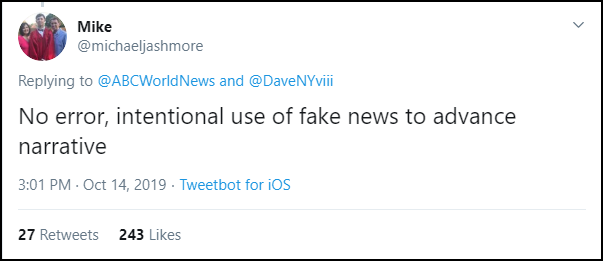By Peter Adams
As politicians continue to attack the credibility of the press, ABC News suffered a self-inflicted wound that is feeding cynical, misguided notions about how news media operate.
On Sunday evening, in a report about violence in northern Syria, ABC’s “World News Tonight“ included a video clip of a nighttime machine gun exhibition at a Kentucky shooting range, with weekend anchor Tom Llamas describing it as “appearing to show Turkey’s military bombing Kurd civilians.” Early Monday morning, shortly before the video was shown again on ABC’s “Good Morning America,” Wojciech Pawelczyk, a conservative political activist, debunked it on Twitter. By midday — after the incident was further investigated by Beckett Adams (no relation), a columnist at The Washington Examiner — ABC News had issued a statement saying it had removed the video and “regrets the error.”
ABC News has declined to comment on how the error occurred.
Into that vacuum of non-information rushed a familiar barrage of cynical accusations — that it wasn’t an error at all, but an intentional use of false footage to advance an ideological agenda:
[the_ad id=“667826”]
These denunciations miss two important things: First, there is no evidence that ABC News knowingly misrepresented the video. Second, knowingly misrepresenting anything is not in the interest of a standards-based news organization.
Presenting videos and photos in false contexts is a common tactic employed by purveyors of misinformation — but it’s almost inevitably exposed. Reverse image search engines, video keyframe analyzers and other tools make it easy for anyone to double-check the authenticity of visuals online.
Intentionally switching the context of a photo or video might be effective for opportunists looking to score cheap political points, or get quick clicks for dishonest ad revenue — but it makes no sense for a mainstream news outlet, especially one with such a large audience, to do that. Whatever short-term gain it might reap by falsely using footage in this manner would be quickly and overwhelmingly reversed by the damage this strategy would do to its reputation once it was uncovered.
[the_ad id=“667872″]
This is a good reminder of a fundamental concept in news literacy: Not all information — including misinformation — is created with the same motivations and processes. Most significant errors and breaches of standards at major news outlets are driven by a desire to break news. The conflict in northern Syria, along with the sudden withdrawal of U.S. troops from the area, is highly newsworthy — and this is most likely what ultimately caused the error.
The footage in question was sensational, a clip that was almost tailor-made for television — and somehow corners were cut in vetting it, and it made it to air. Exactly how this breach of standards happened at ABC won’t be known until the network comes clean and credibly explains what happened.
On Monday, a tweet from Ilhan Tanir, a Turkish journalist, pointed out that the video had been shared to Twitter by Ibrahim Melih Gökçek — a Turkish politician known for spreading disinformation — on Oct. 9, the first day of Turkey’s offensive into northern Syria, claiming that it showed explosions of ammunition that had been provided by the U.S. to Kurdish forces.
On Tuesday, a source at the network told Snopes that the footage came from someone who claimed to be in a “sensitive position” on the Turkish-Syrian border. (A longer version of the machine gun exhibition at the Kentucky gun range has been online since 2017.)
All news outlets make errors, though the overwhelming majority are not this egregious — and while corrections are something every serious journalist laments and works hard to avoid, they are also a strong signal of credibility. ABC not only must be transparent about how this high-profile and damaging error occurred; it also must explain what it will do to ensure that similar errors will not happen again.
The fact that it was quickly corrected after it was called out is a good first step: While it didn’t reverse the damage done, and doesn’t mean that people should stop demanding answers, the correction — with an accompanying apology — was a positive sign that the network did not use the footage with the intent to mislead.
[the_ad id=“667878”]
None of this is intended to excuse ABC’s lapse in standards or let the news division off the hook. But it highlights the need to avoid the pitfalls of adopting cynical, conspiratorial explanations for these kinds of incidents — namely, the debilitating notions that credible information doesn’t exist; that everything we see, read and hear is a tactical manipulation; that it’s all just manufactured narratives and ideological spin.
To embrace that perspective not only seals us off from the most credible sources of information available, it plays right into the hands of people who use such tactics as their stock in trade — those who would have us believe that facts don’t exist, and that nothing can ever be believed.
Peter Adams is the News Literacy Project’s senior vice president of education. He is co-author of The Sift, NLP’s weekly email newsletter for educators, which examines recent examples of misinformation and offers teaching tips and discussion prompts.










“Call me a cynic. Perhaps if this didn’t happen with such regularity I would agree with the topic statement. I believe we are constantly being miss led by media that is owned by only a few corporations having their own agenda at heart. You want to control the masses then control the media. To say “Don’t let ABC’s mistake fuel distrust of the media” is really nothing more than saying “move along now there are no droids here” or “pay no attention to that man behind the curtain”. Media content whether it is social or news is a powerful thing to own. It can be and is filtered, manufactured and manipulated.
>>”First, there is no evidence that ABC News knowingly misrepresented the video.”
That’s the old standard. Today you are guilty until you prove you are innocent. There is no evidence that ABC News unknowingly misrepresented the video.
Oh trust me, I don’t need to use this one, lone incident to fuel distrust in the media. The media does a fine enough job doing that aaaaallllll by itself.
Ever wonder what happens when the “standard” for credible news (mainstream media) has no standards? Look no further than CNN.
“These denunciations miss two important things: First, there is no evidence that ABC News knowingly misrepresented the video. Second, knowingly misrepresenting anything is not in the interest of a standards-based news organization.”
This statement misses two important things. First, ABC News has presented no evidence showing how this video made it to the airwaves, so a position that it was unintentional is just as much speculation as a position that it was intentional. Second, you are presuming that ABC News’ standards are that it is politically unbiased. That is not the impression that I have, nor that of a great many people. As has been pointed out, it beyond statistical probability that random errors would all be in favor of one political orientation, but that is what has happened (and continues to happen). News media rarely rush information that makes Democrats look bad to the airwaves without checking them carefully – or, indeed, bring it to the airwaves at all.
This article begs the question (petitio principii) by assuming the “mistake” was neutral. First, we still don’t know how the supposedly neutral mistake happened. Wouldn’t it be better to know that before concluding it was neutral? Second, at some point, when all or nearly all the supposedly neutral mistakes cut the same direction (i.e., have a bias), then we can’t say, as Mr. Adams does, “there is no evidence that ABC News knowingly misrepresented the video.” In law and in common sense, a biased and reckless approach to truthfulness amounts to knowing misrepresentation. Third, if in fact ABC does have a biased approach to fact gathering and presentation, then we should all be glad to learn that ABC’s mistake fuels distrust in media — as well it should in that case. So, the entire article can be boiled down to, “once one assumes that ABC’s error was a simple, unbiased mistake in good faith then we should conclude that it was a simple, unbiased mistake in good faith.” True, but that’s the petitio principii fallacy.
“Wojciech Pawelczyk, a conservative political activist,”
Two questions:
1) Why is it important to point out Mr. Pawelczyk’s political stance?
2) Why is it not important to point out ABC’s political stance?
“Don’t let ABC’s mistake fuel distrust of the media”
What other major corporations would you make this plea for? Because the press generally hammers major corporations that make mistakes that mislead people.
“ABC News has declined to comment on how the error occurred.”
“Exactly how this breach of standards happened at ABC won’t be known until the network comes clean and credibly explains what happened.”
Based on past experiences the odds are quite low that this will ever happen. How hard are YOU going to push to get them to do so?
“To embrace that perspective not only seals us off from the most credible sources of information available,”
This presumes that ABC is one of the most credible sources of information available. Many, many people are re-examining this presumption. Perhaps you should as well.
“namely, the debilitating notions that credible information doesn’t exist; that everything we see, read and hear is a tactical manipulation; that it’s all just manufactured narratives and ideological spin.”
This statement in and of itself is misleading and shows bias towards the mainstream media. People don’t think that credible information doesn’t exist. What this kind of incident makes people think is that ABC – and it’s ilk in the mainstream media – are biased and manipulated, that *they* manufacture narratives and ideological spin. People still think that credible information exists. But they are starting to understand that we have to depend on people such as Wojciech Pawelczyk and Beckett Adams, not ABC, to provide it.
“Most significant errors and breaches of standards at major news outlets are driven by a desire to break news. The conflict in northern Syria, along with the sudden withdrawal of U.S. troops from the area, is highly newsworthy — and this is most likely what ultimately caused the error.”
What caused the error is that the people today who claim to be journalists have in fact abandoned one of the prime directives of actual journalism; “If your mother says she loves you, check it out.” The function of journalism is to uncover facts, separate them from rumor and innuendo, and then present them to the public so that it can make informed decisions. But these days media outlets happily present innuendo and rumor in order to get the public’s attention. And it’s rather clear as to what kind of rumors and innuendo they prefer to publish.
“The footage in question was sensational, a clip that was almost tailor-made for television”
Which should have raised their suspicion right there.
No. No benefit of the doubt should be offered.
Have you ever seen one of these “mistakes” cast Republicans, Christians, businessmen, police officers, or white people in a *more* favorable light than the facts warranted? Never, not once in my decades of watching the news, have I seen such a thing.
These aren’t mistakes at all. The news media can NEVER be trusted.
This “error” did not happen in a vacuum. The seemingly deliberate errors, all negative to the current Republican administration, have been non-stop. Anyone who has been part of a college campus where there is a School of Journalism knows that these “errors” simply reflect the Far Left mindset of journalists in general. Let’s not pretend otherwise.